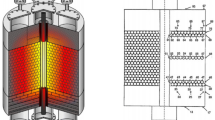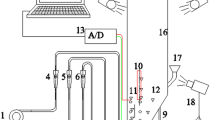Abstract
This paper presents a numerical investigation into thermal–fluid phenomena in a supercritical carbon dioxide-cooled pebble bed reactor (SCPBR) core under steady state using computational fluid dynamic. In this study, a three-dimensional model with the capability to simulate the fluid flow and heat transfer in the SCPBR core has been developed. The developed model was implemented on a personal computer using ANSYS Fluent 14.5. Several important fluid flow and heat transfer parameters have been examined, including the pressure drop over the reactor core, the heat transfer coefficient, the temperature distribution, the coolant density and the coolant velocity. Results obtained from the simulation show that with increasing the inlet Reynolds number, the pressure drop, the coolant density and the heat transfer coefficient increase. However, the coolant temperature and the temperature difference between pebble and coolant decrease with increasing the inlet Reynolds number. The conclusion of the analysis is that supercritical carbon dioxide (S-CO\(_{2})\), compared to other coolants such as helium, could be a suitable coolant for use in a pebble bed reactor due to its large mass density and heat transfer characteristics, which could lead to obtain a higher temperature rise and a lower pressure gradient.
Similar content being viewed by others
Abbreviations
- \(a_\mathrm{sf}\) :
-
Surface area per unit volume (1/m)
- \(C_{p}\) :
-
Specific heat capacity [J/(kg K)]
- d :
-
Diameter of the fuel sphere (pebble) (m)
- \(d_\mathrm{peb}\) :
-
Diameter of pebble (m)
- e :
-
Emissivity of pebble
- \(G_\mathrm{K}\) :
-
Generation of turbulence kinetic energy [\(\hbox {kg}/ (\hbox {m}\,\hbox {s}^{3})\)]
- \(h_\mathrm{sf}\) :
-
Fluid–solid heat transfer coefficient (\(\hbox {W}/(\hbox {m}^{2}\) \(\hbox {K})\))
- k :
-
Turbulence kinetic energy (\(\hbox {m}^{2}/\hbox {s}^{2}\))
- p :
-
Pebble bed packing fraction
- P :
-
Pressure (Pa)
- \(Q_{\mathrm{th}}\) :
-
Thermal power
- Q :
-
Flow rate
- Re :
-
Reynolds number
- Pr :
-
Prandtl number
- \(S_\mathrm{h}\) :
-
Heat source (\(\hbox {W/m}^{3}\))
- T :
-
Pebble temperature (K)
- \(\Delta T\) :
-
Inlet–outlet temperature difference (K)
- u :
-
Superficial mean exit velocity (m/s)
- v :
-
Velocity (m/s)
- \(\varepsilon \) :
-
Bed porosity
- \(\varepsilon _{\mathrm{e}}\) :
-
Energy dissipation rate (\(\hbox {m}^{2}/\hbox {s}^{3}\))
- \(\varepsilon _{b}\) :
-
Volumetric porosity
- \(\mu \) :
-
Dynamic viscosity [kg/(m s)]
- \(\mu _{\mathrm{t}}\) :
-
Turbulent viscosity [kg/ (m s)]
- \(\rho \) :
-
Fluid density (\(\hbox {kg/m}^{3}\))
- \(\rho _{\mathrm{fuel} }\) :
-
Power density of each fuel sphere (\(\hbox {W/m}^{3}\))
- \(\sigma \) :
-
Stefan–Boltzmann constant \(=\) 5.670 \(\times \)\(10^{-8} [\hbox {W}/ (\hbox {m}^{2}\, \hbox {K}^{4})\)]
- \(\lambda _\mathrm{f}\) :
-
Fluid thermal conductivity [W/(m K)]
- \(\lambda _\mathrm{peb}\) :
-
Thermal conductivity of pebble [W/(m K)]
- \(\lambda _\mathrm{s}\) :
-
Solid thermal conductivity [W/(m K)]
References
Lohnert, G.: Technical design features and essential safety-related properties of the HTR-module. Nucl. Eng. Des. 121, 259–275 (1990)
Guo, W.; Ying, A.; Ni, M.J.; Abdou, M.A.: Influence of 2D and 3D convection–diffusion flow on tritium permeation in helium cooled solid breeder blanket units. Fusion Eng. Des. 81, 1465–1470 (2006)
Van Rooyen, W.J.; Krueger, D.L.W.; Mathews, E.H.; Kleingeld, M.: Simulation and optimissation of gas storage tanks filled with heat sink. Nucl. Eng. Des. 236, 156–163 (2006)
Van Der Merwe, J.; Van Ravenswaay, J.P.: Flownex Version 6.4 User Manual. MTech Industrial, Potchefstroom (2003)
Becker, S.; Laurien, E.: Three-dimensional numerical simulation of flow and heat transport in high-temperature nuclear reactors. Nucl. Eng. Des. 222, 189–201 (2003)
Atmaca, M.; Girgin, I.; Ezgi, C.: CFD modeling of a diesel evaporator used in fuel cell systems. Int. J. Hydrog. Energy 41(14), 6004–6012 (2016)
Latifi, M.S.; Setayeshi, S.; Starace, G.; Fiorentino, M.: A numerical investigation on the influence of porosity on the steady state and transient thermal–hydraulic behaviour of the PBMR. ASME J. Heat Trans. 138(10), 102003-1–102003-9 (2016)
Latifi, M.S.; Setayeshi, S.: Numerical simulation of thermal fluid dynamics in the PBMR core. Spec. Top. Rev. Porous Media 7(1), 67–76 (2016)
Oukil, Kh; Sidi-Ali, K.; Alem, A.; Hassani, T.; Amri, Y.: Porous media applied to pebble bed modular reactor thermal–hydraulics. J. Sci. Res. 6, 19–23 (2013)
Van Rooijen, W.F.G.: Improving fuel cycle design and safety characteristics of a gas cooled fast reactor. IOS Press, Amsterdam (2006)
Yu, D.; Peng, M.; Wang, Z.: CFD study on the supercritical carbon dioxide cooled pebble bed reactor. Nucl. Eng. Des. 281, 88–95 (2015)
Reitsma, F.; Strydom, G.; de Haas, J.B.M.; Ivanov, K.; Tyobeka, B.; Mphahlele, R.; Downar, T.J.; Seker, V.; Gougar, H.D.; Da Cruz, D.F.; Sikik, U.E.: The PBMR steady-state and coupled kinetics core thermal–hydraulics benchmark test problems. Nucl. Eng. Des. 236, 657–668 (2006)
Chang Oh.; Kim, E.; Schultz, R.; Patterson, M.; Petti, D.: Thermal hydraulics of the very high temperature gas cooled reactor. In: The 13th International Topical Meeting on Nuclear Reactor Thermal Hydraulics (NURETH-13) Kanazawa, Japan. September 27–October 2, 2009
Ergun, S.: Fluid flow through packed columns. Chem. Process Eng. 48(2), 89–94 (1952)
Macdonald, I.F.; et al.: Flow through porous media-the Ergun equation revisited. Ind. Eng. Chem. Fundam. 18(3), 199–208 (1979)
Kaviany, M.: Principles of Heat Transfer in Porous Media. Springer, New York (1995)
Hsu, C.-T.: Heat conduction in porous media. In: Vafai, K. (ed.) Handbook of Porous Media. Marcel Dekker Inc, New York (2000)
Launder, B.E.; Spalding, D.B.: The numerical computational of turbulent flows. Comput. Methods Appl. Mech. Eng. 3, 269 (1973)
Celik, I.B.: Introductory Turbulence Modeling. West Virginia University Mechanical and Aerospace Engineering Department, Morgantown (1999)
Benenati, R.F.; Browsilow, C.B.: Void fraction distribution in beds of spheres. AIChE 8(3), 359–361 (1962)
Vortmeyer, D.; Schuster, J.: Evaluation of steady flow profiles in rectangular and circular packed beds by a variational method. Chem. Eng. Sci. 38, 1691–1699 (1983)
Du Toit, C.G.: Radial variation in porosity in annular packed beds. Nucl. Eng. Des. 238, 3073–3079 (2008)
http://webbook.nist.gov/cgi/fluid.cgi?ID=C124389&Action=PageHrBHrB (2016). Accessed 20 Sept 2016
Pantankar, S.V.: Numerical Heat Transfer and Fluid Flow, 1st edn. Hemisphere Publishing, Washington, DC (1980)
Ferziger, Joel H.; Peric, Milovan: Computational Methods for Fluid Dynamics, 3rd edn. Springer, Berlin (2002)
ANSYS Inc.: FLUENT R14.5 User’s Guide. ANSYS, Canonsburg (2012)
Nuclear Safety Standards Commission (KTA): KTA 3102.2 reactor core design of high-temperature gas-cooled reactors. Part 2: Heat Spherical Fuel Elements, KTA Safety Standard Issue 6/86, Germany (1983)
Heil, J, et al.: Zusammenstellung von Gleichung fuer den Druckverlust und den Warmeubergang fuer Stroemungen in Kugelschuttungen und prismatischen kanalen, IRE/I-20 ((1969). Heil, 1969)
Anthony, G.D.: The length effect on packed bed effective heat transfer parameters. Chem. Eng. J. 31(3), 163–173 (1985)
Anthony, G.D.; van Dongeren, J.H.: The influence of the tube and particle diameters at constant ratio on heat transfer in packed beds. Chem. Eng. Process. Process Intensif. 37(1), 23–32 (1998)
Demirel, Y.; Sharma, R.N.; Al-Ali, H.H.: On the effective heat transfer parameters in a packed bed. Int. J. Heat Mass Transf. 43(2), 327–332 (2000)
Nijemeisland, M.; Anthony, G.D.: Comparison of CFD simulations to experiment for convective heat transfer in a gas-solid fixed bed. Chem. Eng. J. 82(1), 231–246 (2001)
Author information
Authors and Affiliations
Corresponding author
Rights and permissions
About this article
Cite this article
Latifi, M.S., du Toit, C.G. A Numerical Study to Investigate the Effect of Inlet Reynolds Number on the Thermal–Fluid Phenomena in the Supercritical Carbon Dioxide-Cooled Pebble Bed Reactor. Arab J Sci Eng 44, 981–991 (2019). https://doi.org/10.1007/s13369-018-3352-6
Received:
Accepted:
Published:
Issue Date:
DOI: https://doi.org/10.1007/s13369-018-3352-6




